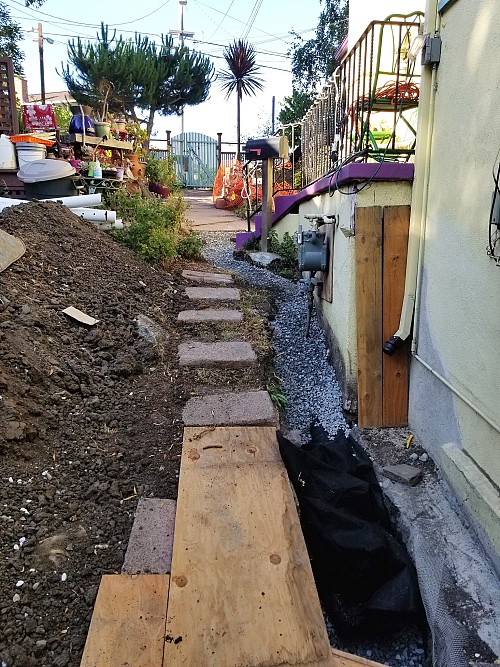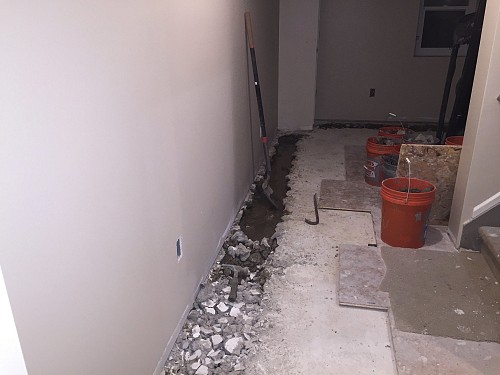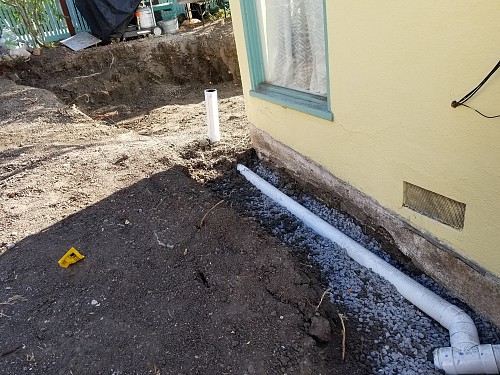French Drains: When You Should Have Them & How They Help
 A damp basement is bad news for homeowners, and a flooded basement is even worse. How can you protect your property? One solution is French drain installation in your yard or basement. Find out what it’s all about.
A damp basement is bad news for homeowners, and a flooded basement is even worse. How can you protect your property? One solution is French drain installation in your yard or basement. Find out what it’s all about.
What Are French Drains?
French drains are a system of trenches and water pipes, designed to drain off groundwater. Residential French drain installation keeps excess moisture away from structures like your home’s foundation and basement, retaining walls, and patios. A French drain may be either outdoors underground or indoors adjacent to a basement floor.
Oh, and that name? French drains were developed in the 19th century by the multitalented Henry Flagg French.
Exterior French Drain Installation
When you hire French drain installers, these are the usual steps they’ll follow for exterior installation:
- Determine the best location, usually on a slope above your house, to divert water that would otherwise run downward toward the structure. Find an outlet point.
- Excavate a trench, running horizontally across the slope. Care must be taken not to disturb existing underground plumbing pipes.
- Line the trench with a water-permeable membrane to keep out tree roots, sand, and soil.
- Cover the membrane with 3 inches of compacted pebble gravel.
- Install a water inlet grate.
- Insert a perforated plastic pipe extending from the inlet grate to the outlet point, perforations facing downward.
- Test the drain by pouring water into the inlet grate.
- Top the piping with 3 inches of crushed stone or pebble gravel, keeping the top below ground level.
- Add a layer of filter fabric.
- Protect the inlet grate temporarily while filling the French drain trench with topsoil.
- Cover the topsoil with a permeable surface such as landscaping stone or grass sod.
Recommended Exterior French Drain Measurements
Depth. 18-24 inches for a house built on a concrete slab foundation; 6 feet for a house with basement.
Width. Minimum 12-24 inches, to accommodate piping 4-5 inches in diameter.
Slope. 1 inch slope for every 8 feet in length.
Distance from house or other structure. Usually 6 feet.
Hole spacing on pipe. 2 rows of holes 6 inches apart.
Interior French Drain Installation
- Jackhammer the concrete flooring around the perimeter of your basement.
- Place a layer of gravel in the trench just formed.
- Install perforated piping, same as for exterior installation.
- Finish the floor with fresh concrete, leaving a 2-inch gap around the perimeter which permits water to enter via the basement walls.
- Install a sump pump to safely remove water.
Why and When Should You Install a French Drain?
Large amounts of storm water or melting snow runoff that pool (or flood!) in your yard signal that you might need this type of drainage system. Other indications include:
- High relative humidity in your basement (usually above 60%)
- Musty odors and/or visible mold in the basement
- Wet, darkened, or bulging walls
- Water spotting which appears on floors, concrete slab, or wall joists
- Stains or cracks in your foundation. Foundation cracks result from excessive moisture accumulating in the foundation walls, and then freezing.
IMPORTANT: If you already have a French drain installation, call for expert inspection should you notice any of the trouble signs listed above. Your drain may have become clogged with leaves, roots, sand, mud, limescale, or sludgy iron ochre deposits. Detected early enough, it can be professionally cleared out with high-pressure water jets. (An interior French drain is much less vulnerable to clogs.)
If you live in an area with cold winters, the best time of year for French drain installation is the summer or fall. In winter the ground will be frozen and in spring it may be too wet to allow for efficient excavation.
Will You Need a Permit to Install French Drains?
Your municipality may require you or your French drain installers to pull a permit, whether for the drain itself or for the necessary excavation – possibly both. Check with your local building authority before work begins.
Looking for a Pro? Call us (866) 441-6648

Plumbing Average Costs
Plumbers Experiences

Clearing A Bathtub Drain Makes It Run Smoother Than Ever

Gas Line Installation Made Simple






